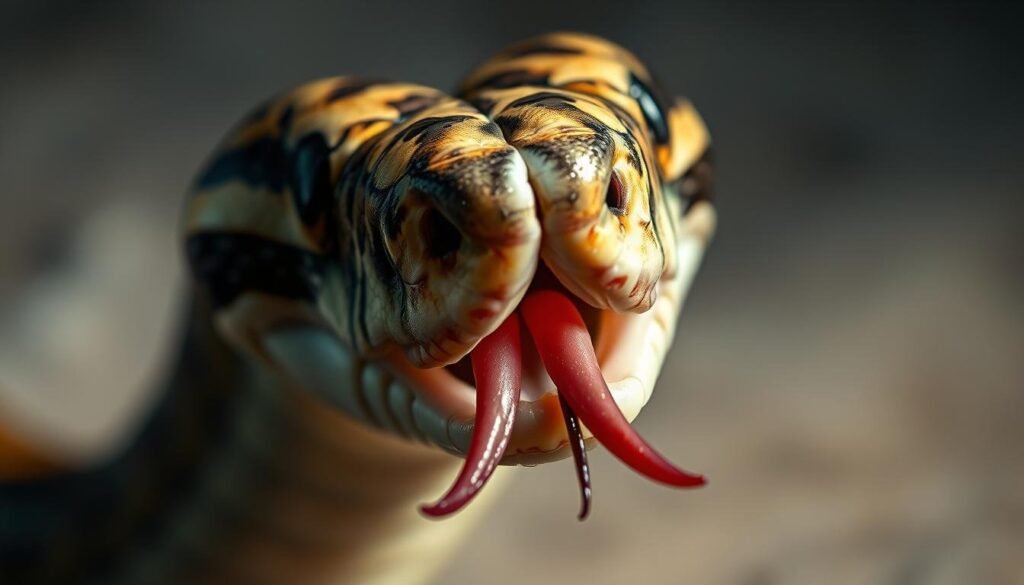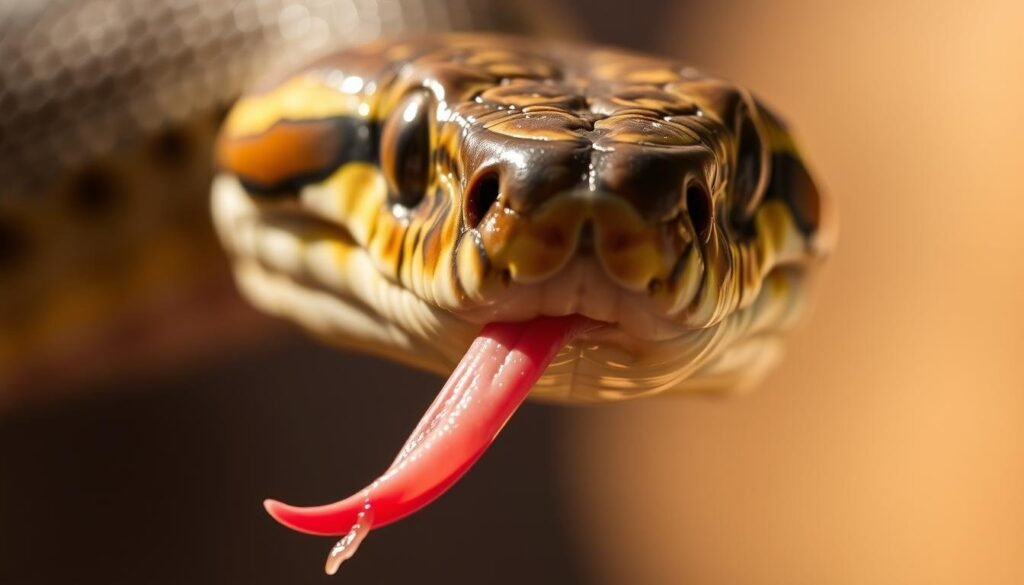Why Do Snakes Flick Their Tongues? You might have seen snakes darting their tongues in and out. It looks like they’re tasting the air. But it’s more than just a curious sight; it’s essential for how snakes live in their environment.
This behavior is linked to snake behavior and reptile senses. Learning about snake tongue flicking opens a window into the complex world of reptiles.
As we dive into this topic, you’ll see how snake tongue flicking is key to their lives. It affects their hunting and survival.
Contents
- 1 The Curious Behavior of Snake Tongue Flicking
- 2 The Anatomy of a Snake’s Tongue
- 3 Why Do Snakes Flick Tongues When Sensing Environment?
- 4 The Jacobson’s Organ: The Brain Behind the Tongue
- 5 Evolutionary Advantages and Scientific Research
- 6 Conclusion: Why Do Snakes Flick Their Tongues?
- 7 FAQ
- 7.1 Why do snakes flick their tongues?
- 7.2 What is the significance of a snake’s forked tongue?
- 7.3 How does the Jacobson’s Organ process chemical cues?
- 7.4 What is the role of tongue flicking in a snake’s survival?
- 7.5 How does the frequency of tongue flicking vary in snakes?
- 7.6 What have scientists learned from studying snake tongue flicking?
The Curious Behavior of Snake Tongue Flicking
Tongue flicking in snakes is a deliberate action. It plays a crucial role in their interaction with the environment. By flicking their tongues, snakes gather chemical cues. These cues are essential for locating prey, detecting predators, and navigating their territory.
The frequency and speed of tongue flicking can vary. This depends on the snake’s level of interest or alertness. For example, a hunting snake will flick its tongue more rapidly than a resting one. This behavior shows the snake’s state of awareness and its engagement with the environment.
The table below summarizes the key aspects of snake tongue flicking behavior and its significance.
| Behavior | Significance | Environmental Cue |
|---|---|---|
| Rapid Tongue Flicking | Indicates heightened alertness or hunting | Presence of prey or predator |
| Slow Tongue Flicking | Indicates relaxation or reduced alertness | Absence of immediate threats |
| Tongue Flicking Frequency | Varies with the snake’s interest or threat level | Environmental exploration |
In conclusion, the tongue flicking behavior of snakes is complex and essential. It allows them to interact with their environment effectively. Understanding this behavior provides insights into the fascinating world of snake senses.
The Anatomy of a Snake’s Tongue
A snake’s tongue is more than just an appendage. It’s a complex tool for gathering information. Its anatomy is key to how snakes navigate and hunt.
The tongue is a flexible, muscular structure. It’s very sensitive to its surroundings. When a snake flicks its tongue, it collects chemical samples. These samples help the snake understand its environment.
The Forked Tip and Its Significance
The forked tip of a snake’s tongue is very distinctive. This forked shape lets the snake collect two samples at once. It’s essential for the snake’s ability to sense its surroundings.
The forked tip helps the snake track prey, detect predators, and move through its territory. It’s a vital part of the snake’s sensory system.
| Feature | Description | Significance |
|---|---|---|
| Forked Tip | The tongue’s tip is divided into two prongs | Enhances the snake’s ability to detect chemical cues and track prey |
| Muscular Structure | The tongue is highly muscular and flexible | Allows for rapid and precise movement, facilitating the collection of chemical samples |
| Sensory Capability | The tongue is highly sensitive to environmental chemicals | Enables the snake to build a detailed picture of its surroundings, aiding in navigation and hunting |
In conclusion, the anatomy of a snake’s tongue, especially its forked tip, is crucial. It allows snakes to gather and analyze chemical information. This is vital for their survival.
Why Do Snakes Flick Tongues When Sensing Environment?
Snakes flick their tongues to gather important info about their surroundings. This helps them survive by finding food, avoiding danger, and finding mates. They collect chemical samples to make smart choices about hunting, defense, and finding a mate.
The tongue flicking process is a complex mechanism. It shows how snakes adapt and survive in different environments. When a snake flicks its tongue, it picks up chemical particles from around it. These particles are then analyzed by the Jacobson’s organ, a special sensory system.
The info snakes get from tongue flicking is crucial for their daily lives. Here are some main reasons why they do it:
- Detecting prey: Snakes can find the chemical signs of food, helping them catch it.
- Avoiding predators: By sensing predators, snakes can avoid danger.
- Finding mates: Snakes use tongue flicking to find pheromones from potential mates, helping with reproduction.
In short, tongue flicking is key to a snake’s sensory toolkit. It lets them effectively navigate and interact with their environment. This ability shows the complex relationship between snakes and their ecosystems.
The Jacobson’s Organ: The Brain Behind the Tongue
The Jacobson’s Organ is key in processing what a snake’s tongue picks up. It helps the snake move around its space well. This special organ analyzes chemical signals from the snake’s tongue when it flicks it.
When a snake flicks its tongue, it picks up chemicals from its area. These chemicals go to the Jacobson’s Organ in the snake’s mouth. The organ has special cells that catch these chemical signals. This lets the snake “smell” its world in a unique way.
Function and Importance
The Jacobson’s Organ is very important for a snake. It helps the snake find food, avoid dangers, and know its surroundings. By reading chemical signals, the snake gets a detailed view of its world. This is key for its survival.
| Function | Description | Importance |
|---|---|---|
| Prey Detection | Analyzes chemical cues to locate prey | Essential for hunting and feeding |
| Predator Avoidance | Detects chemical signals from predators | Crucial for survival |
| Environmental Navigation | Helps in understanding the chemical landscape | Important for migration and habitat selection |

In short, the Jacobson’s Organ is a crucial part of a snake’s senses. It works with the snake’s tongue to understand its world. This shows how amazing snakes are at adapting and sensing their surroundings.
Evolutionary Advantages and Scientific Research
Snakes’ tongue flicking is more than just a quirky behavior. It’s a key survival tool that has been studied by scientists. By flicking their tongues, snakes can sense their surroundings. This includes finding food, avoiding danger, and even finding a mate.
Studies have found that how well snakes flick their tongues depends on their environment. For example, some snakes adjust how often they flick their tongues based on their surroundings. This shows how their unique way of sensing the world helps them survive.
Scientists keep digging into how snakes use tongue flicking. This research helps us understand snakes better and how to protect them. It also shows us how snakes interact with their world in amazing ways.
Conclusion: Why Do Snakes Flick Their Tongues?
Now you know how snakes flick their tongues is a cool example of evolution. This action helps snakes sense their world. It lets them gather important info about their surroundings.
The snake’s tongue and the Jacobson’s Organ make a special way to sense things. This article showed how amazing this system is. It shows how complex and interesting snakes are.
Learning about snakes’ tongue flicking makes us appreciate nature more. It shows us how diverse and complex life is. It makes us see how special snakes are.
See Also: Discover Why Penguins Huddle in Cold Temperatures?
FAQ
Why do snakes flick their tongues?
Snakes flick their tongues to pick up chemical cues. This helps them find food, spot dangers, and know their territory.
What is the significance of a snake’s forked tongue?
The forked tongue lets snakes get two chemical samples at once. This boosts their ability to sense where and how strong the chemical cues are.
How does the Jacobson’s Organ process chemical cues?
The Jacobson’s Organ breaks down the chemical samples from the tongue. It sends this info to the snake’s brain. This lets the snake understand its surroundings and act accordingly.
What is the role of tongue flicking in a snake’s survival?
Tongue flicking is key for a snake’s survival. It helps them find food, avoid predators, and find mates. This way, they can make smart choices about hunting, defending themselves, and reproducing.
How does the frequency of tongue flicking vary in snakes?
The speed and frequency of tongue flicking change based on the snake’s interest or alertness. It shows how aware they are.
What have scientists learned from studying snake tongue flicking?
Scientists have learned a lot about snakes by studying tongue flicking. This knowledge helps with conservation and makes us appreciate these animals more.

Zyair Larson, based in Denver, Colorado, has over 12 years of experience studying animal behavior. He has worked with the World Wildlife Fund (WWF) and National Geographic, researching wildlife and sharing insights on animal habits globally.

